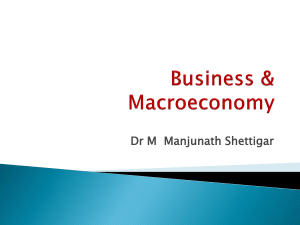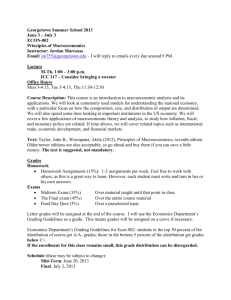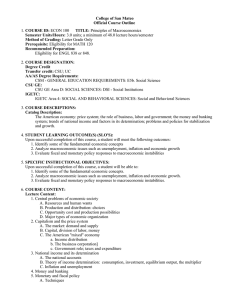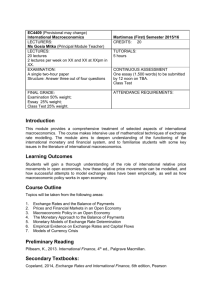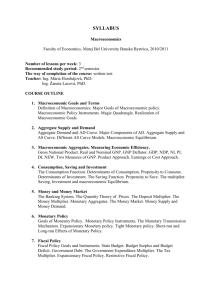HW Assignments - Townsend Harris High School
advertisement
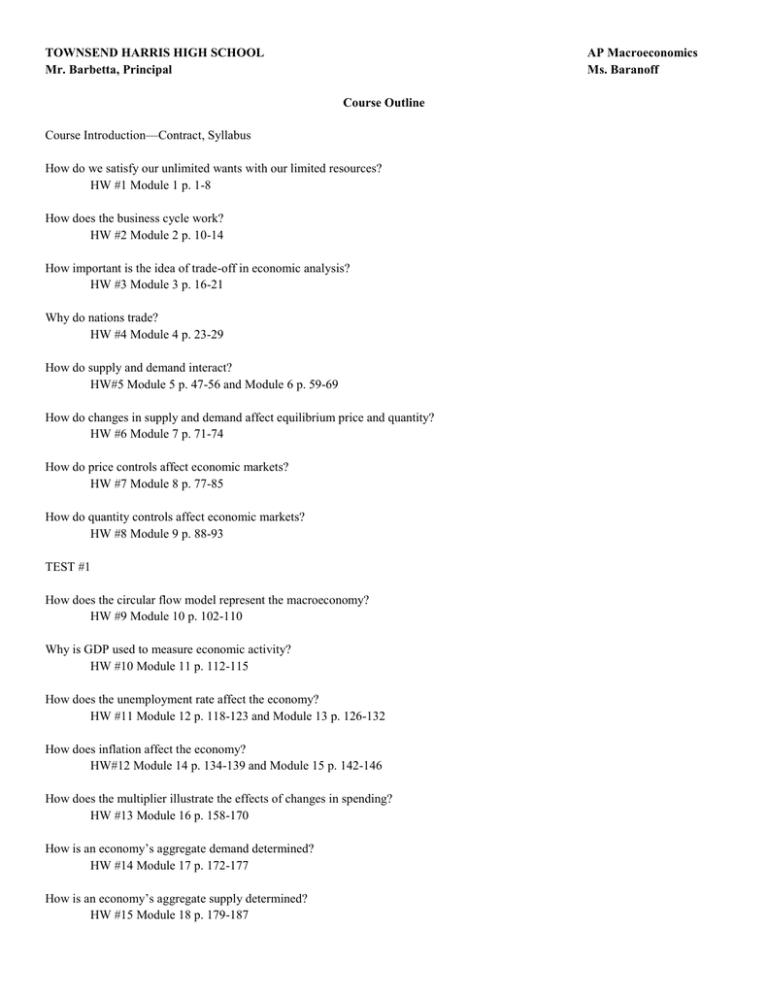
TOWNSEND HARRIS HIGH SCHOOL Mr. Barbetta, Principal AP Macroeconomics Ms. Baranoff Course Outline Course Introduction—Contract, Syllabus How do we satisfy our unlimited wants with our limited resources? HW #1 Module 1 p. 1-8 How does the business cycle work? HW #2 Module 2 p. 10-14 How important is the idea of trade-off in economic analysis? HW #3 Module 3 p. 16-21 Why do nations trade? HW #4 Module 4 p. 23-29 How do supply and demand interact? HW#5 Module 5 p. 47-56 and Module 6 p. 59-69 How do changes in supply and demand affect equilibrium price and quantity? HW #6 Module 7 p. 71-74 How do price controls affect economic markets? HW #7 Module 8 p. 77-85 How do quantity controls affect economic markets? HW #8 Module 9 p. 88-93 TEST #1 How does the circular flow model represent the macroeconomy? HW #9 Module 10 p. 102-110 Why is GDP used to measure economic activity? HW #10 Module 11 p. 112-115 How does the unemployment rate affect the economy? HW #11 Module 12 p. 118-123 and Module 13 p. 126-132 How does inflation affect the economy? HW#12 Module 14 p. 134-139 and Module 15 p. 142-146 How does the multiplier illustrate the effects of changes in spending? HW #13 Module 16 p. 158-170 How is an economy’s aggregate demand determined? HW #14 Module 17 p. 172-177 How is an economy’s aggregate supply determined? HW #15 Module 18 p. 179-187 How do we differentiate between short-run and long-run macroeconomic equilibrium? HW #16 Module 19 p. 190-196 How does fiscal policy aim to manage economic fluctuations? HW #17 Module 20 p. 199-207 Why does fiscal policy have a multiplier effect? HW #18 Module 21 p. 209-212 TEST #2 How does a nation’s financial system affect its economic development? HW #19 Module 22 p. 221-229 Why is money an integral part of an economic system? HW #20 Module 23 p. 231-235 and Module 24 p. 237-241 How do banks contribute to the macroeconomy? HW #21 Module 25 p. 243-251 How does the Federal Reserve respond to economic crises? HW #22 Module 26 p. 253-260 How does the Fed execute monetary policy? HW #23 Module 27 p. 262-266 How is the market for money determined? HW #24 Module 28 p. 268-275 How is the market for loanable funds determined? HW #25 Module 29 p. 277-286 TEST #3 How does fiscal policy affect the economy in the long-run? HW #26 Module 30 p. 296-304 Why is monetary policy the primary tool for stabilizing the economy? HW #27 Module 31 p. 307-312 How does monetary policy affect the economy in the long-run? HW #28 Module 32 p. 315-319 How does inflation affect the economy? HW #29 Module 33 p. 321-328 Why are inflation and unemployment interrelated? HW #30 Module 34 p. 331-341 How have views of macroeconomics changed over time? HW #31 Module 35 p. 343-353 How is macroeconomics viewed today? HW #32 Module 36 p. 355-359 TEST #4 How is long-run economic growth measured? HW #33 Module 37 p. 367-373 How is productivity related to economic growth? HW #34 Module 38 p. 376-385 Why do economies grow at different rates? HW #35 Module 39 p. 387-395 How do macroeconomic models represent long-run economic growth? HW #36 Module 40 p. 398-403 How do balance of payments accounts keep track of capital flows? HW #37 Module 41 p. 409-418 How are exchange rates determined? HW #38 Module 42 p. 421-428 How do nations select an exchange rate regime? HW #39 Module 43 p. 431-434 How is macroeconomic policy affected by exchange rates? HW #40 Module 44 p. 437-440 How can we use macroeconomic models to conduct policy analysis? HW #41 Module 45 p. 443-450 TEST #5 Review for AP Exam
